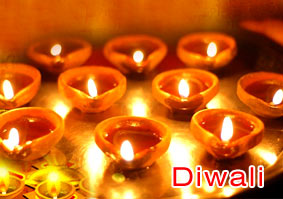Diwali rangoli making is the art of adorning the doorsteps of the house with splendid designs. The rangoli is basically a floor painting that is usually based on a theme. Popular motifs include birds, fishes, lotus and snakes, which is indicative of the unanimity between the man and the animals. Celestial images like that of sun and moon are increasingly finding their way in the making of rangoli designs.
 The designing of two interfaced triangles represents Saraswati, the
Goddess of learning and knowledge. The twenty four petal lotus flower is
drawn in such a manner that it encircles the triangles. In the outer
circle, the footprints of Goddess Lakshmi are drawn. For each corner,
there is a footprint. The designing of rangoli differs from place to
place like in North Bihar; the footprints of Lakshmi are drawn in such a
way that the toes point inwards, indicating the entry of Laxmi in the
house.
The designing of two interfaced triangles represents Saraswati, the
Goddess of learning and knowledge. The twenty four petal lotus flower is
drawn in such a manner that it encircles the triangles. In the outer
circle, the footprints of Goddess Lakshmi are drawn. For each corner,
there is a footprint. The designing of rangoli differs from place to
place like in North Bihar; the footprints of Lakshmi are drawn in such a
way that the toes point inwards, indicating the entry of Laxmi in the
house.All that goes in the making of a rangoli comprises of rice flour, pulses, leaves and a sincere effort. Mostly, you'll get to see rangolis in white color, as it is a color that stands for purity, peace and serenity. Rice is a symbol of prosperity. Therefore, a paste is prepared from rice and used for creating wonderful rangolis for Diwali. To fill the white rangoli for giving it a distinctive look, people sometimes use turmeric. Vermillion is also increasingly heading its way towards rangoli, as it is considered highly auspicious.







